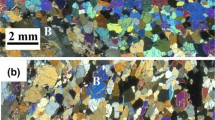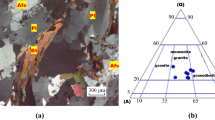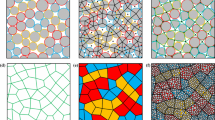Abstract
The excavation of deep underground engineering causes a sophisticated three-dimensional stress redistribution in the surrounding rock, leading to the damage and rupture of the surrounding rock. It is difficult to reveal the fracture mechanism of rocks under complex stress loading path changes through conventional uniaxial or triaxial stress tests. In this study, a marble dual-scale 3DEC-GBM (grain-based modeling) discrete element model was established. The model was according to the practical mineral component of marble and its particle size distribution characteristics. Through laboratory true triaxial tests and numerical simulations, investigations were conducted on the deformation and strength characteristics of marble under true triaxial stress states. The evolution process and characteristics of anisotropic fracture and its microscopic tensile and shear fracture mechanism were also thoroughly investigated. Subsequently, the effects of intermediate principal stress σ2 and minimum principal stress σ3 on the intergranular and transgranular failures of marble as well as cracked anisotropy were analyzed, and the tensile–shear failure mechanism and crack anisotropy evolution law of the marble fracture evolution were determined under different true triaxial stress conditions. Finally, the effects of mineral crystal micromechanical parameters on the mechanical characteristics of marble under true triaxial conditions were examined.
Highlights
-
Macro-meso failure mechanisms of anisotropic deformation and failure of marble induced by true triaxial stresses were revealed through tests and simulations.
-
Pre- and post-peak microcrack anisotropic propagation processes and tensile‒shear mechanisms of marble under true triaxial stresses (σ2, σ3) were investigated.
-
Effects of 3DEC-GBM model meso parameters on mechanical behavior of rock were explored.
































Similar content being viewed by others
Data Availability
The authors confirm they have included a data availability statement in their main manuscript file. The datasets generated and/or analyzed during the current study are available from the corresponding author on reasonable request.
Abbreviations
- 3D:
-
Three-dimension
- 3DEC:
-
Three-dimensional distinct Element
- PFC3D:
-
Three-dimensional particle flow
- GBM:
-
Grain-based model
- SEM:
-
Scanning electron microscopy
- σ 1, σ 2 and σ 3 :
-
Maximum, intermediate and minimum principal stresses, respectively
- σ c, σ r :
-
Peak strength, residual strength, respectively
- ε 1, ε 2 and ε 3 :
-
Maximum, intermediate and minimum principal strains, respectively
- ε c :
-
Peak strain
- UCS:
-
Uniaxial compressive strength
- Ρ, E, υ :
-
Density, Young’s modulus, Poisson’s ratio, respectively
- c, φ :
-
Friction angle, cohesion, respectively
- c r, φ r :
-
Residual friction angle, residual cohesion, respectively
- K, G:
-
Shear modulus, bulk modulus, respectively
- ∆Z min :
-
Normal minimum length of deformation element
- σ ij, Δσ ij :
-
Stress of tetrahedral grains, stress increment of tetrahedral grains, respectively
- Δε ij, δ ij :
-
Strain increment of tetrahedral grains, Kroenecker increment, respectively
- α 2 :
-
Material constants related to bulk modulus and shear modulus
- F n, F s :
-
Contact normal force, contact tangential force, respectively
- ∆ U n, ∆ U s :
-
Contact normal displacement increment, contact tangential force displacement increment, respectively
- T max, F s m ax :
-
Contact maximum tensile force, contact maximum shear force, respectively
- Fs r:
-
Residual shear strength
- A c :
-
Contact area
- τ oct, σ m ,2 :
-
Octahedral shear stress, octahedral effective intermediate stress, respectively
- a, b :
-
Material parameters
- ρ, e, μ :
-
Density, young’s modulus, poisson’s ratio, respectively
- jk n, jk s :
-
Normal stiffness, shear stiffness, respectively
- jf, j c, jt :
-
Friction angle, cohesion, tensile strength, respectively
- jf r, jc r, jt r :
-
Residual friction angle, residual cohesion, residual tensile strength, respectively
References
Al-Ajmi AM, Zimmerman RW (2005) Relation between the Mogi and the Coulomb failure criteria. Int J Rock Mech Min 42(3):431–439
Azocar KD (2016) Investigating the mesh dependency and upscaling of 3D grain-based models for the simulation of brittle fracture processes in low-porosity crystalline rock. Dissertation, Queen’s University (Canada)
Chen X, Liao Z, Peng X (2012) Deformability characteristics of jointed rock masses under uniaxial compression. Int J Min Sci Techno 22(2):213–221
Chen W, Konietzky H, Tan X, Frühwirt T (2016) Pre-failure damage analysis for brittle rocks under triaxial compression. Comput Geotech 74:45–55
Chen S, Li H, Zhou H, Chen X, Liu T (2021) Route selection of deep-lying and hard rock tunnel in the Sichuan-Tibet Railway based on rock burst risk assessment. Q J Eng Geol Hydroge 48(5):81–90
Cundall PA (1988) Formulation of a three-dimensional distinct element model. Int J Rock Mech Min Sci & Geomech 25(3):107–116
Fabjan T, Ivars DM, Vukadin V (2015) Numerical simulation of intact rock behaviour via the continuum and Voronoi tesselletion models: A sensitivity analysis. Acta Geotech Slov 12(2):5–23
Fairhurst CE, Hudson JA (1999) Draft ISRM suggested method for the complete stress-strain curve for intact rock in uniaxial compression. Int J Rock Mech Min 36(3):279–289
Farahmand K, Vazaios I, Diederichs MS, Vlachopoulos N (2018) Investigating the scale-dependency of the geometrical and mechanical properties of a moderately jointed rock using a synthetic rock mass (SRM) approach. Comput Geotech 95:162–179
Farahmand K, Diederichs MS (2015) A calibrated Synthetic Rock Mass (SRM) model for simulating crack growth in granitic rock considering grain scale heterogeneity of polycrystalline rock, In 49th US Rock Mechanics/Geomechanics Symposium
Feng XT, Guo HS, Yang CX, Li SJ (2018) In situ observation and evaluation of zonal disintegration affected by existing fractures in deep hard rock tunneling. Eng Geol 242(14):1–11
Feng XT, Haimson B, Li XC, Chang CD, Ma XD, Zhang XW, Suzuki K (2019) ISRM suggested method: determining deformation and failure characteristics of rocks subjected to true triaxial compression. Rock Mech Rock Eng 52:2011–2020
Fu TF, Xu T, Zhu WC, Wang XW (2020) Damage Characteristics of Sandstone Under Triaxial Compression Based on Polycrystalline Discrete Element Method. J Northeast Univ (nat Sci) 41(7):968
Gao FQ, Stead D (2014) The application of a modified Voronoi logic to brittle fracture modelling at the laboratory and field scale. Int J Rock Mech Min 68:1–14
Gao FQ, Stead D, Elmo D (2016) Numerical simulation of microstructure of brittle rock using a grain-breakable distinct element grain-based model. Comput Geotech 78:203–217
Ge X, Ren J, Pu Y, Ma W, Zhu Y (2001) Real-in time CT test of the rock meso-damage propagation law. Sci China Ser E 44:328–336
Ghazvinian E (2014) 3D random Voronoi grain-based models for simulation of brittle rock damage and fabric-guided micro-fracturing. J Rock Mech Geotech 6(6):506–521
Haimson B, Rudnicki JW (2010) The effect of the intermediate principal stress on fault formation and fault angle in siltstone. J Struct Geol 32(11):1701–1711
Handin J, Heard HC, Magouirk JN (1967) Effects of the intermediate principal stress on the failure of limestone, dolomite, and glass at different temperatures and strain rates. J Geophys Res 72(2):611–640
He MC, Miao JL, Feng JL (2010) Rock burst process of limestone and its acoustic emission characteristics under true-triaxial unloading conditions. Int J Rock Mech Min 47(2):286–298
He BG, Wang L, Feng XT, Zhen RL (2023) Failure Modes of Jointed Granite Subjected to Weak Dynamic Disturbance Under True-Triaxial Compression. Rock Mech Rock Eng 56:7939–7956
Hoek E, Marinos PG, Marinos VP (2005) Characterisation and engineering properties of tectonically undisturbed but lithologically varied sedimentary rock masses. Int J Rock Mech Min Sci 42(2):277–285
Jia L, Chen M, Zhang W, Xu T, Zhou Y, Hou B, ** Y (2013) Experimental study and numerical modeling of brittle fracture of carbonate rock under uniaxial compression. Mech Res Commun 50:58–62
Jiang Q, Song LB (2018) Application and prospect of 3D printing technology to physical modeling in rock mechanics. Chin J Rock Mech Eng 37(1):23–37
Jiang Q, Feng XT, **ang TB, Su GS (2010) Rockburst characteristics and numerical simulation based on a new energy index: a case study of a tunnel at 2500 m depth. Bull Eng Geol Environ 69:381–388
Jiang Q, Zhong S, Cui J, Feng XT, Song L (2016) Statistical characterization of the mechanical parameters of intact rock under triaxial compression an experimental proof of the ** marble. Rock Mech Rock Eng 49:4631–4646
Kaiser PK, Kim B, Bewick RP, Valley, (2011) Rock mass strength at depth and implications for pillar design. Min Technol 120:170–179
Kazerani T, Zhao J (2010) Micromechanical parameters in bonded particle method for modelling of brittle material failure. Int J Numer Anal Met 34(18):1877–1895
Knauth M, Minkley W (2014) Modeling of the mechanical and hydraulic behavior of salt rocks on a discontinuum-mechanical basis, In 48th US Rock Mechanics/Geomechanics Symposium
Li C, Prikryl R, Nordlund E (1998) The stress-strain behaviour of rock material related to fracture under compression. Eng Geol 49(3–4):293–302
Li XF, Li HB, Zhao J (2017) 3D polycrystalline discrete element method (3PDEM) for simulation of crack initiation and propagation in granular rock. Comput Geotech 90:96–112
Li X, Feng F, Li D, Du K, Ranjith PG, Rostami J (2018a) Failure characteristics of granite influenced by sample height-to-width ratios and intermediate principal stress under true-triaxial unloading conditions. Rock Mech Rock Eng 51:1321–1345
Li XF, Zhang QB, Li HB, Zhao J (2018b) Grain-based discrete element method (GB-DEM) modelling of multi-scale fracturing in rocks under dynamic loading. Rock Mech Rock Eng 51:3785–3817
Liang K, **e L, He B, Zhao P, Zhang Y, Hu W (2021) Effects of grain size distributions on the macro-mechanical behavior of rock salt using micro-based multiscale methods. Int J Rock Mech Min 138:104592
Ma T, Lin D, Tang L, Li L, Tang CA, Yadav KP, ** W (2022) Characteristics of rockburst and early warning of microseismic monitoring at qinling water tunnel. Geomat Nat Haz Risk 13(1):1366–1394
Mair K, Abe S (2009) Effects of gouge fragment shape on fault friction: New 3D modeling results. Geophys Res Lett 36(23):557–620
Mayer JM, Stead D (2017) Exploration into the causes of uncertainty in UDEC Grain Boundary Models. Comput Geotech 82:110–123
Mcbeck J, Mair K, Renard F (2019) How porosity controls macroscopic failure via propagating fractures and percolating force chains in porous granular rocks. J Geophys Res-Sol Ea 124(9):9920–9939
Mogi K (1967) Effect of the intermediate principal stress on rock failure. J Geophys Res 72(20):5117–5131
Mogi K (1971) Effect of the triaxial stress system on the failure of dolomite and limestone. Tectonophysics 11(2):111–127
Müller C, Frühwirt T, Haase D, Schlegel R, Konietzky H (2018) Modeling deformation and damage of rock salt using the discrete element method. Int J Rock Mech Min 103:230–241
Nicksiar M, Martin CD (2014) Factors Affecting Crack Initiation in Low Porosity Crystalline Rocks. Rock Mech Rock Eng 47(4):1165–1181
Park CH, Bobet A (2010) Crack initiation, propagation and coalescence from frictional flaws in uniaxial compression. Eng Fract Mech 77(14):2727–2748
Peng J, Wong LNY, Teh CI (2017) Influence of grain size heterogeneity on strength and microcracking behavior of crystalline rocks. J Geophys Res-Sol Ea 122(2):1054–1073
Peng J, Wong LNY, Teh CI (2021) Influence of grain size on strength of polymineralic crystalline rock: New insights from DEM grain-based modeling. J Rock Mech Geotech 13(4):755–766
Potyondy DO, Cundall PA (2004) A bonded-particle model for rock. Int J Rock Mech Min 41(8):1329–1364
Potyondy DO (2010) A grain-based model for rock: approaching the true microstructure, Proceedings of rock mechanics in the Nordic Countries 9–12
Sinha S, Walton G (2021) Importance of block damage in confined laboratory-scale Bonded Block Model simulations, In 55th US Rock Mechanics/Geomechanics Symposium
Sinha S, Walton G (2020) A study on Bonded Block Model (BBM) complexity for simulation of laboratory-scale stress-strain behavior in granitic rocks. Comput Geotech 118:103363
Takahashi M, Koide H (1989) Effect of the intermediate principal stress on strength and deformation behavior of sedimentary rocks at the depth shallower than 2000 m, In ISRM international symposium
Wang X, Cai M (2018) Modeling of brittle rock failure considering inter- and intra-grain contact failures. Comput Geotech 101:224–244
Wang X, Cai M (2019) A comprehensive parametric study of grain-based models for rock failure process simulation. Int J Rock Mech Min 115:60–76
Wang B, Chen Y, Wong TF (2008) A discrete element model for the development of compaction localization in granular rock. J Geophys Res Sol 113:B3
Wang Z, Wang T, Wu S, Hao Y (2021) Investigation of microcracking behaviors in brittle rock using polygonal grain-based distinct method. Int J Numer Anal Met 45(13):1871–1899
Xu T, Fu TF, Heap MJ, Meredith PG, Mitchell TM, Baud P (2020) Mesoscopic damage and fracturing of heterogeneous brittle rocks based on three-dimensional polycrystalline discrete element method. Rock Mech Rock Eng 53:5389–5409
Yang YM, Ju Y, Chen JL, Gao F (2014) Cracks development features and energy mechanism of dense sandstone subjected to triaxial stress. Chin J Rock Mech Eng 33(4):691–698
Yao C, Jiang QH, Shao JF (2015) Numerical simulation of damage and failure in brittle rocks using a modified rigid block spring method. Comput Geotech 64:48–60
Zhao XG, Wang J, Cai M, Cheng C, Ma LK, Su R, Li DJ (2014) Influence of unloading rate on the strainburst characteristics of Beishan granite under true-triaxial unloading conditions. Rock Mech Rock Eng 47:467–483
Zheng Z, Feng XT, Zhang X, Zhao J, Yang CX (2019) Residual strength characteristics of CJPL marble under true triaxial compression. Rock Mech Rock Eng 52:1247–1256
Zheng Z, Feng XT, Yang CX, Zhang XW, Li SJ, Qiu SL (2020) Post-peak deformation and failure behaviour of **** marble under true triaxial stresses. Eng Geol 265:105444
Zheng Z, Su GS, Jiang Q, Pan PZ, Huang XH, Jiang JQ (2022) Mechanical behavior and failure mechanisms of cylindrical and prismatic rock specimens under various confining stresses. Int J Damage Mech 31(6):864–881
Zheng Z, Su H, Mei GS, Wang W, Liu H, Zhang Q, Wang YJ (2023a) A thermodynamic damage model for 3D stress-induced mechanical characteristics and brittle–ductile transition of rock. Int J Damage Mech 32(4):623–648
Zheng Z, Cai ZY, Su GS, Huang SL, Wang W, Zhang Q, Wang YJ (2023b) A new fractional-order model for time-dependent damage of rock under true triaxial stresses. Int J Damage Mech 32(1):50–72
Zheng Z, Deng B, Li SJ, Zheng H (2023c) Disturbance mechanical behaviors and anisotropic fracturing mechanisms of rock under novel three‑stage true triaxial static‑dynamic coupling loading. Rock Mech Rock Eng. https://doi.org/10.1007/s00603-023-03696-3
Zheng Z, Tang H, Zhang Q, Pan PZ, Zhang XW, Mei GX, Wang W (2023d) True triaxial test and PFC3D-GBM simulation study on mechanical properties and fracture evolution mechanisms of rock under high stresses. Comput Geotech 154:105136
Zheng Z, Li RH, Zhang Q (2023e) A novel anisotropic deterioration mechanical model for rock ductile–brittle failure under 3D high-stress and its application. Comput Geotech 162:105665
Zheng Z, Xu HY, Zhang K, Feng GL, Zhang Q, Zhao YF (2024a) Intermittent disturbance mechanical behavior and fractional deterioration mechanical model of rock under complex true triaxial stress paths. IJMST 34(1):17–136
Zheng Z, Deng B, Liu H, Wang H, Huang SL, Li SJ (2024b). Microdynamic mechanical properties and fracture evolution mechanism of monzogabbro with a true triaxial multilevel disturbance method. IJMST. https://doi.org/10.1016/j.ijmst.2024.01.0012095-26
Zheng Z, Li RH, Zhang Q, Huang XH, Wang W, Huang SL (2024c) Mechanical parameter evolutions and deterioration constitutive model for ductile-brittle failure of surrounding rock in high-stress underground engineering. Underground Space 15:131–152
Zhu DF, Tu SH, Ma HS, Zhang XW (2017) A 3D Voronoi and subdivision model for calibration of rock properties. Model Simul Mater Sc 25(8):085005
Acknowledgements
The authors acknowledge the financial support received from the National Natural Science Foundation of China (Grant No. 52109119), the Guangxi Natural Science Foundation (Grant No. 2021GXNSFBA075030), and the Open Research Fund of State Key Laboratory of Simulation and Regulation of Water Cycle in River Basin (China Institute of Water Resources and Hydropower Research) (Grant No.IWHR-SKL-202202), the Guangxi Science and Technology Project (Grant No. GuikeAD20325002), and the China Postdoctoral Science Foundation Project (Grant No. 2022M723408). The authors sincerely thank Professor **a-Ting Feng and his teams for their help in the experiment.
Author information
Authors and Affiliations
Contributions
ZZ: conceptualization, experiment, methodology, writing, software; SL: data analysis, writing—editing and review; ZQ: investigation, writing-original draft, visualization; QZ: data analysis, software, writing—editing and review, supervision.
Corresponding authors
Ethics declarations
Conflict of interest
The authors declare that they have no known competing financial interests or personal relationships that could have appeared to influence the work reported in this paper.
Additional information
Publisher's Note
Springer Nature remains neutral with regard to jurisdictional claims in published maps and institutional affiliations.
Rights and permissions
Springer Nature or its licensor (e.g. a society or other partner) holds exclusive rights to this article under a publishing agreement with the author(s) or other rightsholder(s); author self-archiving of the accepted manuscript version of this article is solely governed by the terms of such publishing agreement and applicable law.
About this article
Cite this article
Zheng, Z., Li, S., Qin, Z. et al. Dual-scale 3DEC-GBM Discrete Element Simulation On Mechanical Behavior and Anisotropic Fracture Evolution Mechanism of Rock Induced by True Three-dimensional Stress. Rock Mech Rock Eng 57, 3885–3915 (2024). https://doi.org/10.1007/s00603-023-03754-w
Received:
Accepted:
Published:
Issue Date:
DOI: https://doi.org/10.1007/s00603-023-03754-w




